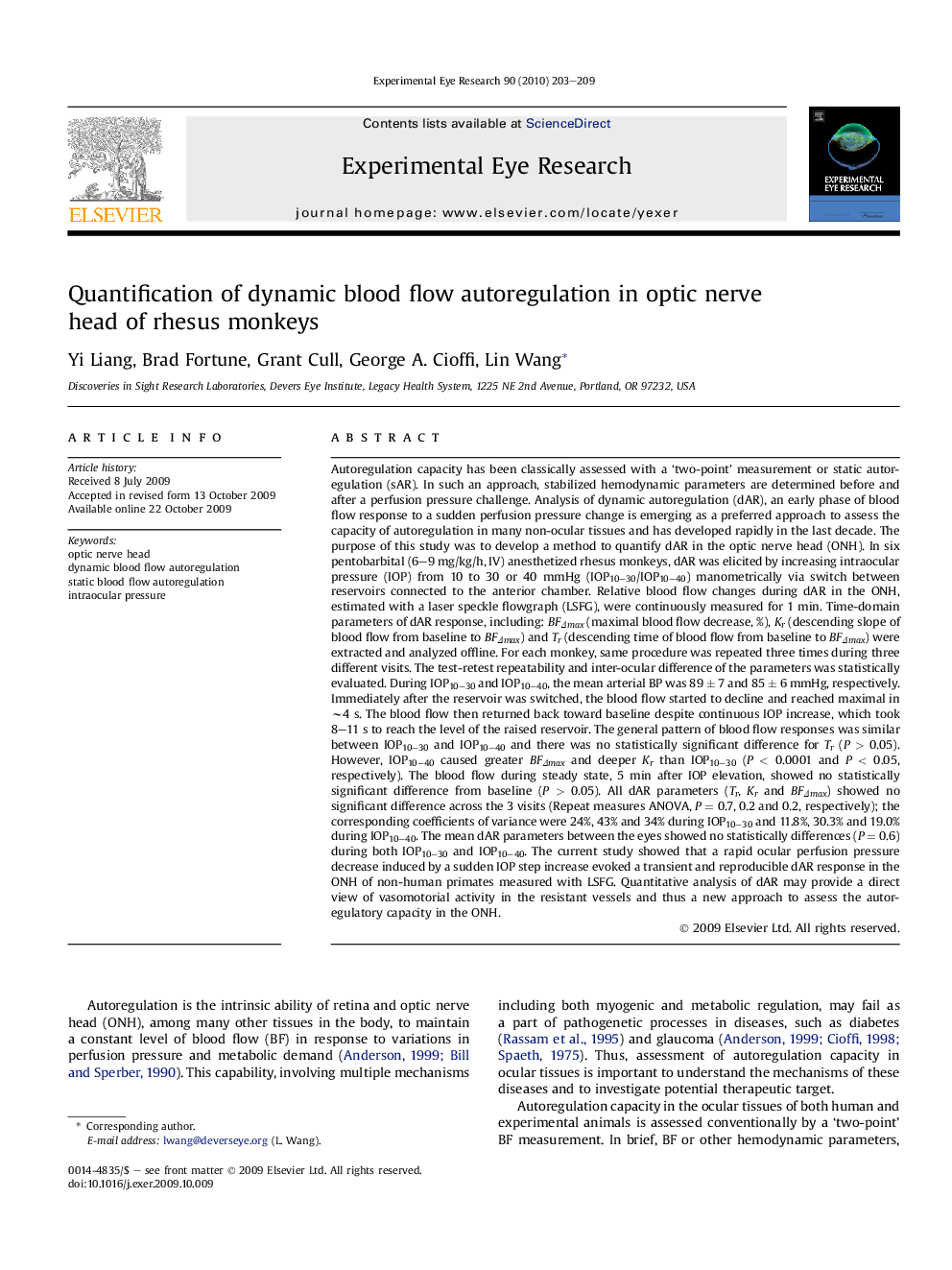| کد مقاله | کد نشریه | سال انتشار | مقاله انگلیسی | نسخه تمام متن |
|---|---|---|---|---|
| 4012030 | 1261176 | 2010 | 7 صفحه PDF | دانلود رایگان |

Autoregulation capacity has been classically assessed with a ‘two-point’ measurement or static autoregulation (sAR). In such an approach, stabilized hemodynamic parameters are determined before and after a perfusion pressure challenge. Analysis of dynamic autoregulation (dAR), an early phase of blood flow response to a sudden perfusion pressure change is emerging as a preferred approach to assess the capacity of autoregulation in many non-ocular tissues and has developed rapidly in the last decade. The purpose of this study was to develop a method to quantify dAR in the optic nerve head (ONH). In six pentobarbital (6–9 mg/kg/h, IV) anesthetized rhesus monkeys, dAR was elicited by increasing intraocular pressure (IOP) from 10 to 30 or 40 mmHg (IOP10–30/IOP10–40) manometrically via switch between reservoirs connected to the anterior chamber. Relative blood flow changes during dAR in the ONH, estimated with a laser speckle flowgraph (LSFG), were continuously measured for 1 min. Time-domain parameters of dAR response, including: BFΔmax (maximal blood flow decrease, %), Kr (descending slope of blood flow from baseline to BFΔmax) and Tr (descending time of blood flow from baseline to BFΔmax) were extracted and analyzed offline. For each monkey, same procedure was repeated three times during three different visits. The test-retest repeatability and inter-ocular difference of the parameters was statistically evaluated. During IOP10–30 and IOP10–40, the mean arterial BP was 89 ± 7 and 85 ± 6 mmHg, respectively. Immediately after the reservoir was switched, the blood flow started to decline and reached maximal in ∼4 s. The blood flow then returned back toward baseline despite continuous IOP increase, which took 8–11 s to reach the level of the raised reservoir. The general pattern of blood flow responses was similar between IOP10–30 and IOP10–40 and there was no statistically significant difference for Tr (P > 0.05). However, IOP10–40 caused greater BFΔmax and deeper Kr than IOP10–30 (P < 0.0001 and P < 0.05, respectively). The blood flow during steady state, 5 min after IOP elevation, showed no statistically significant difference from baseline (P > 0.05). All dAR parameters (Tr, Kr and BFΔmax) showed no significant difference across the 3 visits (Repeat measures ANOVA, P = 0.7, 0.2 and 0.2, respectively); the corresponding coefficients of variance were 24%, 43% and 34% during IOP10–30 and 11.8%, 30.3% and 19.0% during IOP10–40. The mean dAR parameters between the eyes showed no statistically differences (P = 0.6) during both IOP10–30 and IOP10–40. The current study showed that a rapid ocular perfusion pressure decrease induced by a sudden IOP step increase evoked a transient and reproducible dAR response in the ONH of non-human primates measured with LSFG. Quantitative analysis of dAR may provide a direct view of vasomotorial activity in the resistant vessels and thus a new approach to assess the autoregulatory capacity in the ONH.
Journal: Experimental Eye Research - Volume 90, Issue 2, February 2010, Pages 203–209